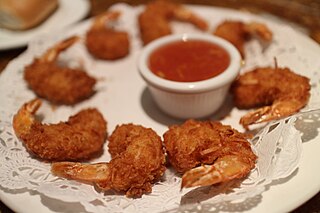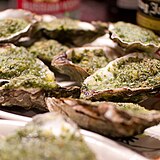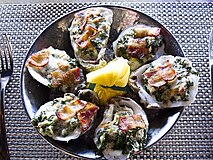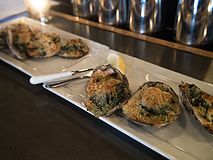
An omelette is a dish made from eggs, fried with butter or oil in a frying pan. It is a common practice for an omelette to include fillings such as chives, vegetables, mushrooms, meat, cheese, onions or some combination of the above. Whole eggs or egg whites are often beaten with a small amount of milk, cream, or water.

Louisiana Creole cuisine is a style of cooking originating in Louisiana, United States, which blends West African, French, Spanish, and Native American influences, as well as influences from the general cuisine of the Southern United States.

A soufflé is a baked egg dish originating in France in the early 18th century. Combined with various other ingredients, it can be served as a savoury main dish or sweetened as a dessert. The word soufflé is the past participle of the French verb souffler, which means to blow, breathe, inflate or puff.

Moussaka is an eggplant (aubergine)- or potato-based dish, often including ground meat, which is common in the Balkans and the Middle East, with many local and regional variations.

Rémoulade is a cold sauce. Although similar to tartar sauce, it is often more yellowish, sometimes flavored with curry, and often contains chopped pickles or piccalilli. It can also contain horseradish, paprika, anchovies, capers and a host of other items.

New Mexican cuisine is the cuisine of the Southwestern US state of New Mexico. The region is primarily known for its fusion of Pueblo Native American cuisine with Hispano Spanish and Mexican cuisine originating in Nuevo México. This Southwestern culinary style is popular beyond the current boundaries of New Mexico, and is found throughout the old territories of Nuevo México and the New Mexico Territory, today the state of Arizona, parts of Texas, and the southern portions of Colorado, Utah, and Nevada.

Czech cuisine has both influenced and been influenced by the cuisines of surrounding countries and nations. Many of the cakes and pastries that are popular in Central Europe originated within the Czech lands. Contemporary Czech cuisine is more meat-based than in previous periods; the current abundance of farmable meat has enriched its presence in regional cuisine. Traditionally, meat has been reserved for once-weekly consumption, typically on weekends.
Oysters en brochette is a classic dish in New Orleans Creole cuisine. Raw oysters are skewered, alternating with pieces of partially cooked bacon. The entire dish is then broiled or breaded then either deep fried or sautéed. The traditional presentation is on triangles of toast with the skewer removed and dusted with salt and pepper or topped with either Maitre d'Hotel butter or a Meunière sauce. When prepared well, the dish should have a crispy exterior and a soft savory center with a textural contrast between the bacon and the oyster. It was usually offered on restaurant menus as an appetizer; but was also a popular lunch entrée.

Angels on horseback is a hot hors d'œuvre or savoury made of oysters wrapped with bacon. The dish, when served atop breads, can also be a canapé.

Eggs Sardou is a Louisiana Creole cuisine dish made with poached eggs, artichoke bottoms, creamed spinach and Hollandaise sauce. It is on the menu of many Creole restaurants in New Orleans, including Antoine's, where eggs Sardou was invented, and at Brennan's. Eggs Sardou is named for Victorien Sardou, a famous French dramatist of the 19th century, who was a guest in New Orleans when the dish was invented.
Bermudian cuisine blends British and Portuguese cuisine with preparations of local seafood species, particularly wahoo and rockfish. Traditional dishes include codfish and potatoes served either with an add-on of hard-boiled egg and butter or olive oil sauce with a banana or in the Portuguese style with tomato-onion sauce, peas and rice. Hoppin' John, pawpaw casserole and fish chowder are also specialties of Bermuda. As most ingredients used in Bermuda's cuisine are imported, local dishes are offered with a global blend, with fish as the major ingredient, in any food eaten at any time.

Clams casino is a clam "on the halfshell" dish with breadcrumbs and bacon. Green peppers are also a common ingredient.

Oysters Bienville is a traditional dish in New Orleans cuisine of baked oysters in a shrimp sauce. It is served at some of the city's renowned restaurants, originating at Arnaud's. Ingredients include shrimp, mushrooms, bell peppers, sherry, a roux with butter, Parmesan cheese and other lighter cheese, and bread crumbs. The oysters are baked in the shell or can be made in a small casserole dish or au gratin dish. The dish was named for Jean-Baptiste Le Moyne de Bienville (1680–1767), French governor of Louisiana and founder of New Orleans.

The cuisine of New Orleans encompasses common dishes and foods in New Orleans, Louisiana. It is perhaps the most distinctively recognized regional cuisine in the United States. Some of the dishes originated in New Orleans, while others are common and popular in the city and surrounding areas, such as the Mississippi River Delta and southern Louisiana. The cuisine of New Orleans is heavily influenced by Creole cuisine, Cajun cuisine, and soul food. Later on, due to immigration, Italian cuisine and Sicilian cuisine also has some influence on the cuisine of New Orleans. Seafood also plays a prominent part in the cuisine. Dishes invented in New Orleans include po' boy and muffuletta sandwiches, oysters Rockefeller and oysters Bienville, pompano en papillote, and bananas Foster, among others.

Swabian cuisine is native to Swabia, a region in southwestern Germany comprising great parts of Württemberg and the Bavarian part of Swabia. Swabian cuisine has a reputation for being rustic, but rich and hearty. Fresh egg pastas, soups, and sausages are among Swabia's best-known types of dishes, and Swabian cuisine tends to require broths or sauces; dishes are rarely "dry".

Lettuce soup is a soup prepared with lettuce as a primary ingredient. It may be prepared with additional ingredients, and some lettuce soups may use several cultivars of lettuce in their preparation. It is a part of French cuisine and Chinese cuisine. Cream of lettuce soup is a type of lettuce soup prepared using milk or cream. The soup may be served with toast or rolls as a side dish or with the soup atop them. It may be served as an appetizer, a side dish or as a main dish, and may be served hot or cold.

Coconut shrimp is a shrimp dish prepared using shrimp and coconut as primary ingredients. It can be prepared as a crunchy dish with the shrimp coated and deep fried, pan-fried or baked, and as a sautéed dish using coconut milk and other ingredients. It can be prepared and served on skewers.



















